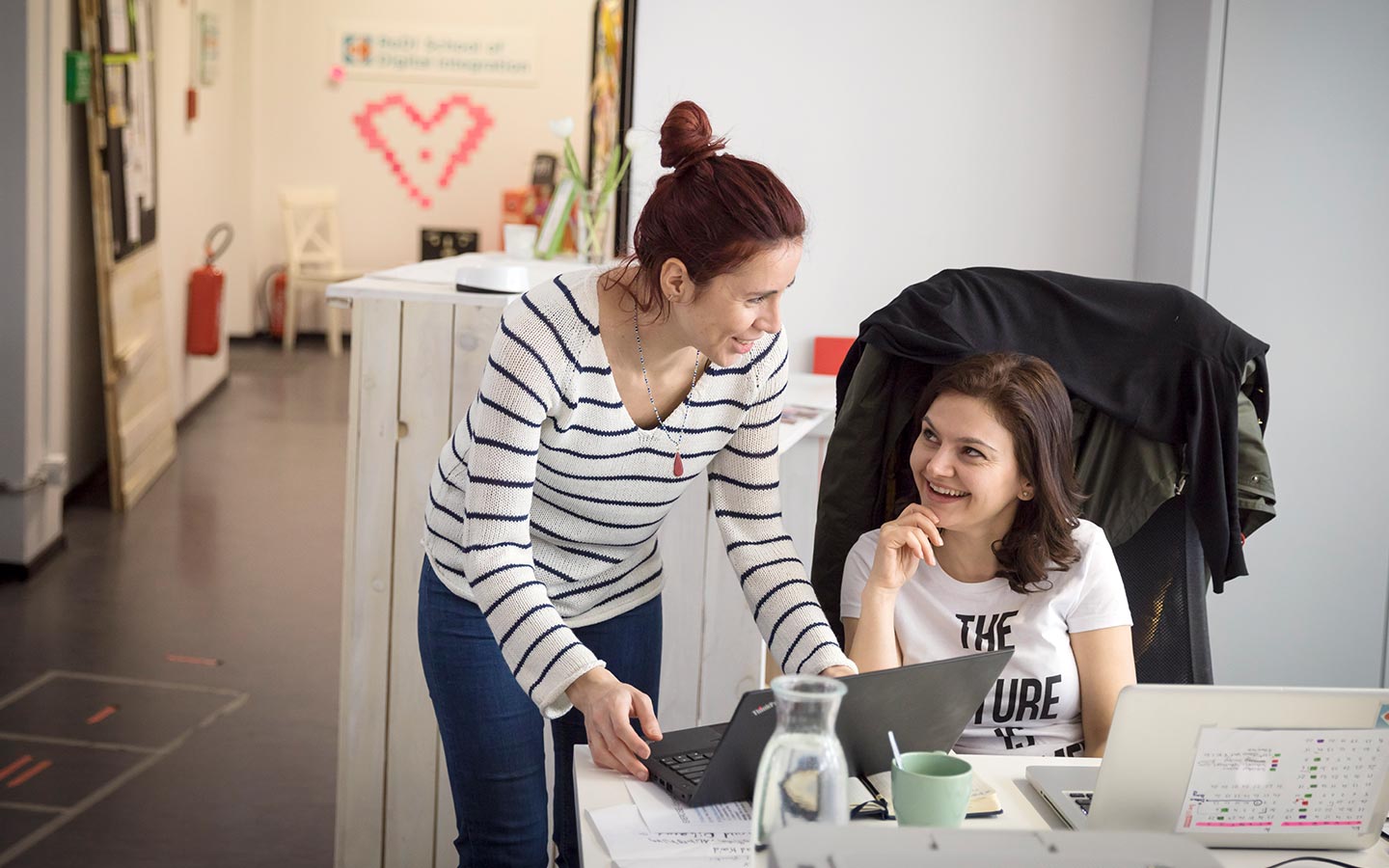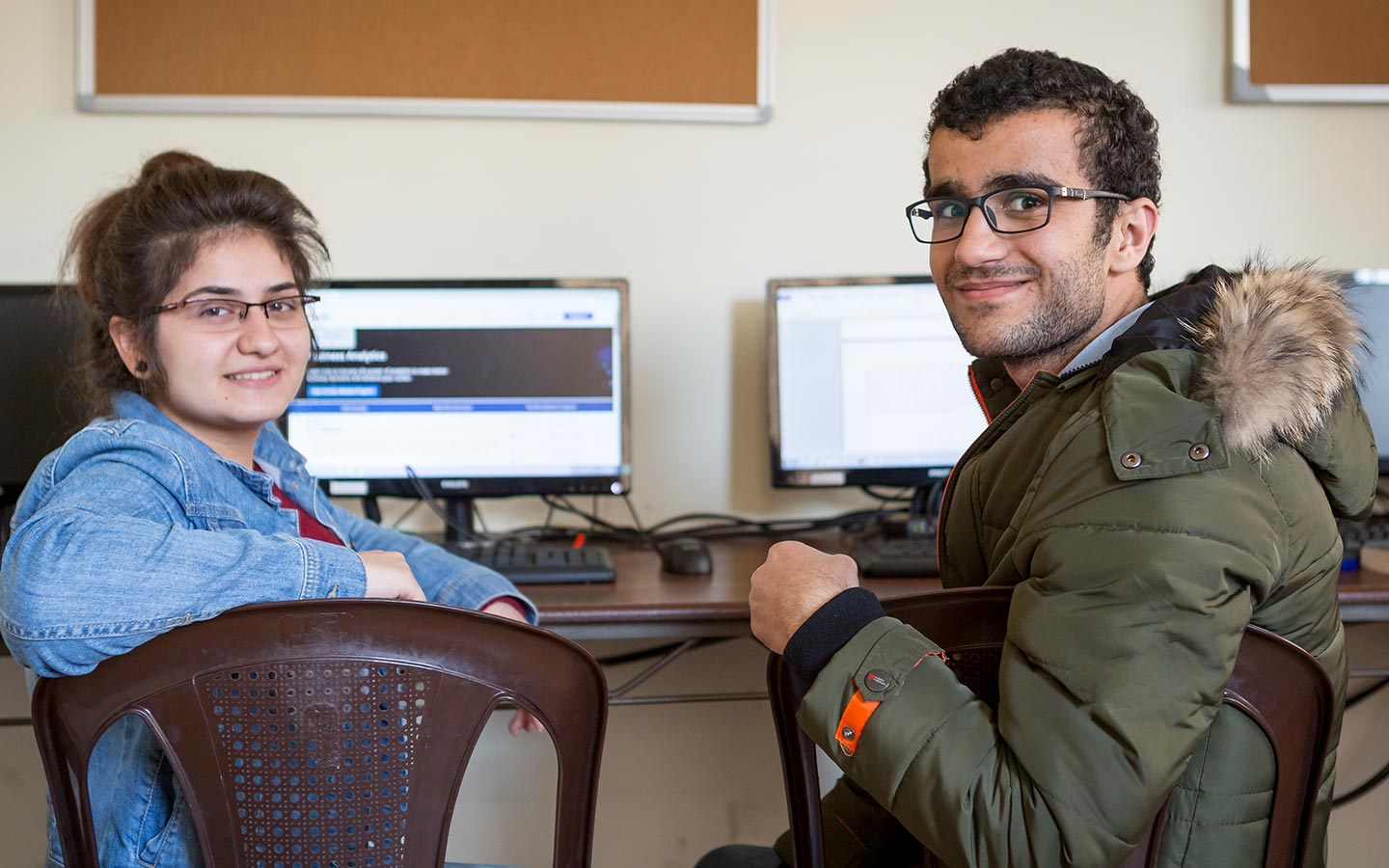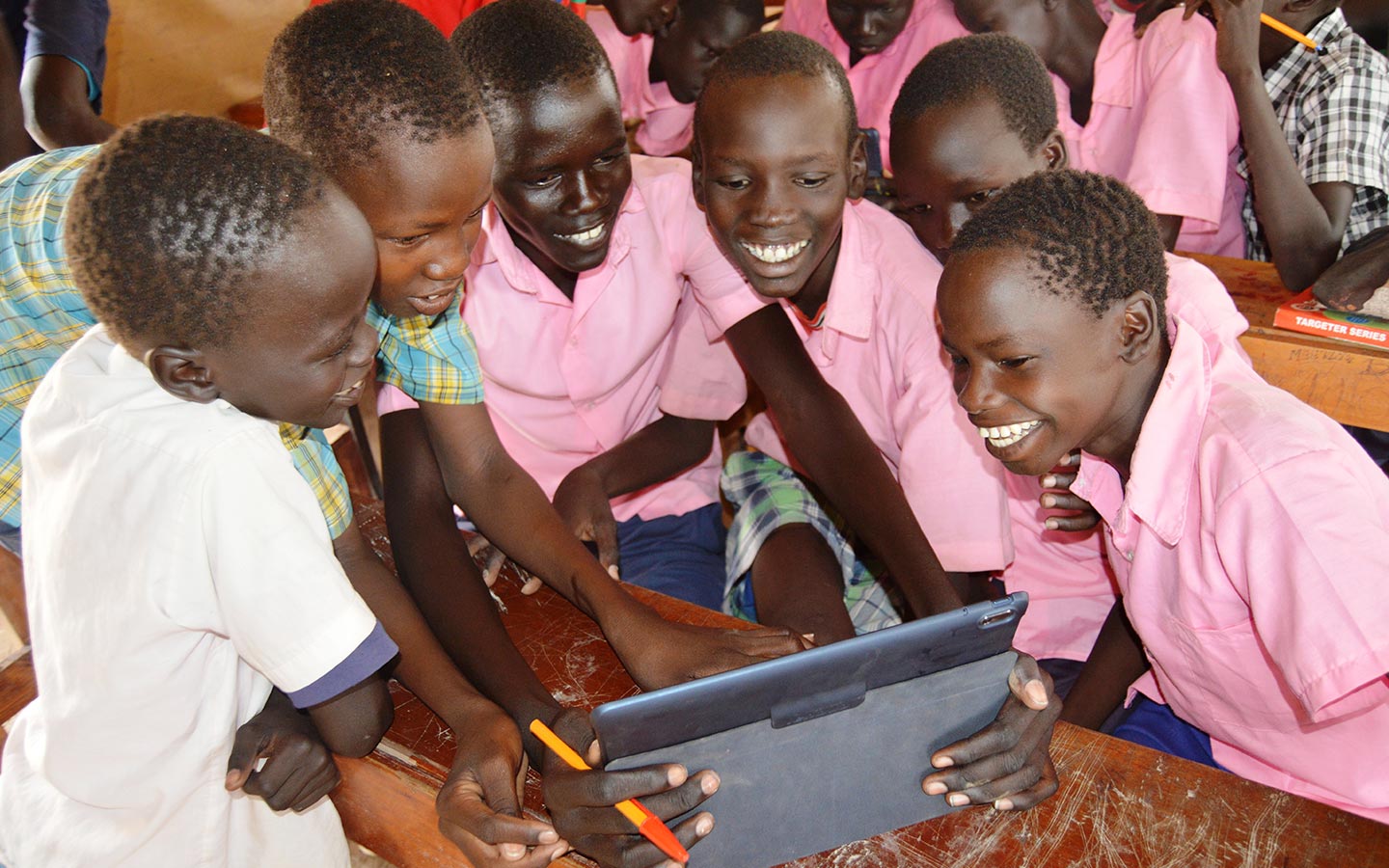CHAPTER 4:
Teaming up with technology
Masha, 9, Ukrainian refugee, learns how to code through a project supported by the IT company EPAM Systems and UNHCR in Minsk, Belarus. ©UNHCR/Egor Dubrovsky
Technology’s rapid rise presents us with some of the most exciting opportunities yet to extend education to refugees.
Digital access and connectivity is immensely important to refugees. Among other things, it can help them overcome feelings of isolation, find peer support and stay connected to family, as well as access learning opportunities from other ends of the globe. A sizeable array of online learning tailored for refugees has emerged, from online courses, lectures and curated content to entire degree programmes.
Access to information does not by itself equate to an education. Drop-out rates from online courses are extremely high, either because the material is not relevant or because students find it hard to stay motivated when they experience a course solely via a computer. This underscores the importance of face-to-face academic support as a component of what are known as blended learning programmes. In the hands of a well qualified teacher, technology is a powerful tool to improve the learning environment, but it must complement teaching, not replace it.

Rita Butman (left), 31, Syrian refugee, is an instructor at ReDI School of Digital Integration in Berlin, Germany. Free coding courses enable refugee women to brush up on computer skills. ©UNHCR/Gordon Welters
There has been significant growth in connected learning at tertiary level; it has become one of the strongest examples of how technology and pedagogy can combine to expand learning in a meaningful way. Connected learning courses gather students in a centre to learn together using online content and tutoring support to complement face-to-face teaching in a way that keeps distance learners engaged. Lectures can be delivered remotely, but are also given by visiting academics and staff who work on location. Without a common campus, students can nonetheless create their own communities, both on site and with their peers on other campuses, and thereby engage in group assignments as well as conventional individual tasks.

Maral Ara Janoian (left), 18, and Abdul-Aziz Jawad Al-Rubaye, 19, Iraqi refugees in Amman, Jordan, take distance learning courses in English and IT at the Jesuit Refugee Service. ©UNHCR/Antoine Tardy
A bridge to the world
The Instant Network Schools programme, a joint project of the Vodafone Foundation and UNHCR, aims to integrate technology in classrooms by providing training, solar power, connectivity and tablets with offline content. The programme places refugees and their host communities at the centre during a three-day design process that culminates in a tailored classroom design. Together they draw out what their ideal classroom looks like and how it will be used. While the teachers’ priorities tend to be for learning resources, like every teenager in the world, refugee students tend to prioritize internet access.
The programme is also a bridge to the world through the Leadership Lesson initiative, with global leaders such as Paul Polman (CEO of Unilever) and Lisa Milroy (Head of Graduate Painting at the Slade School of Fine Art) delivering virtual lessons. Outside school hours, some of these classrooms transform into community hubs, opening up learning opportunities for a much broader group of people. Since the programme began in 2014, the Instant Network Schools project has worked in the Democratic Republic of the Congo, Kenya, South Sudan and Tanzania and has benefitted some 62,000 young refugees and over 850 teachers.

Refugee students in Kakuma refugee camp use a tablet from the Instant Network Schools programme, a collaborative effort by UNHCR and the Vodafone Foundation to improve the quality of education in remote areas with mobile technology. The kit supplied includes tablets, laptops, projectors, speakers, solar-powered batteries, a satellite or mobile network, and a suite of content and online learning material. ©UNHCR/Catherine Wachiaya
The way forward
The advantage of connected learning is that it provides an incredibly cost-effective higher education without the students having to leave their present location (with all the additional expense that entails). Since 2012, over 7,000 refugee and host community students enrolled in connected learning courses in 12 different countries – from France and Germany to Afghanistan, Thailand, Malawi and Iraq – supported by a consortium of 16 partners, including universities, NGOs, UNHCR and foundations. The Connected Learning in Crisis Consortium is co-led by UNHCR and the University of Geneva, leveraging a broad network for innovative expansion of higher education for young refugees.
The game-changing move now would be to replicate, develop and expand connected learning initiatives, having learnt from previous start-ups. To achieve this, it is essential that more businesses, entrepreneurs and education specialists join UNHCR in making digital learning accessible to refugees around the world.
This is why, in short, it is everyone’s business to support the education of refugees.
CASE STUDY
Smart solutions
Refugees develop their tech skills to find answers to everyday problems
Henriette Kiwele, 21, refugee from the Democratic Republic of the Congo, builds an Android app at the AppFactory in Dzaleka refugee camp, Malawi. The App Factory opened in 2017 as part of UNHCR’s Connectivity for Refugees project with Microsoft 4Afrika. ©UNHCR/Tina Ghelli
Remy Gakwaya fled his native Burundi at age 15, after his parents were killed in ethnic clashes. He made it to Dzaleka refugee camp in Malawi in 2008. Ten years later, he is now teaching 20 students how to code and develop apps.
It all started with courses in computer programming supported by the Jesuit Refugee Service at the Jesuit Worldwide Learning centre in the camp, where Remy learnt computer programming languages like HTML, Java and Python.
“I love programming,” says Remy, now 23. “It is inspiring to see something that I create myself. Here in the refugee camp you are not free to do anything. We aren’t able to work outside of the camp. However, if you do programming, you can do it from anywhere in the world.”
In 2016, Remy founded TakeNoLab, a community organization that allows him to share his love of computer languages with young refugees in the camp.
Remy started teaching his six students the basics of how to use a mouse and a keyboard. But due to lack of computers, he had to print images of keyboard layouts which students would take home to practice typing and explain theories of coding, rather than showing them on a computer screen. Frequent power cuts meant classes often had to take place in the dark.
In a joint pilot with UNHCR, Microsoft 4Afrika provided Wi-Fi connectivity throughout the settlement with the support of local internet service providers for 12 months. One thousand smartphones, 40 and laptops and 10 tablets were also provided to help students get a step closer to unlocking their full potential.
In 2017, for the first time, Remy’s students could work online with reliable internet, in proper facilities. The project started with 31 students who had passed a highly competitive aptitude test for enrolment in courses offered at the AppFactory, a Microsoft 4Afrika initiative that aims to build digital skills and coding capabilities of young people.
Apprentice developers spend up to six months working with software technicians from Microsoft, learning to design and code apps to solve problems they encounter in their everyday lives. The magic ingredients in the AppFactory are passion for software development, devotion, teamwork and empowerment.
The first app developed is called Habari. It helps new arrivals find services in the camp and teaches them the basics of English or Chichewa, the national language of Malawi. Another app, Smart Mapokezi, which means “distribution” in Swahili, sends refugees an SMS informing about upcoming food and other items available that day.
“I want to use technology to solve local problems that big software companies do not have the time to take on,” says Remy.
While UNHCR is continuing to support connectivity for the AppFactory beyond the pilot, facilities for alumni remain limited and further support is required to allow graduates of the AppFactory to make the most of their new skills. Most of the students are refugees, and 5 of the 20 active students are young women.
But Remy is undeterred. He recently started a computer club called Girls’ Smart Code to encourage refugee women and girls to join the technological revolution.
Henriette Kiwele, 21, and her sisters Claudine, 18, and Josephine, 17, escaped violence in the Democratic Republic of the Congo in 2013. On arriving in Dzaleka refugee camp they wanted to nothing more than to study.
When Henriette heard that TakeNolab was looking for girls interested in learning to code, she and her sisters joined right away.
“There were mostly boys in the group, and we were asked if we would be able to keep up with them. We said yes, of course we can,” says Henriette. “When I think of the future, I think one day I will be able to have a career based on the knowledge I am getting here at the App Factory,” she adds.
CASE STUDY
Power of Speech
Syrian refugees are teaching Arabic to students all over the world thanks to a language-learning startup.
Shadi, 26, Syrian refugee in Beirut, Lebanon, is one of more than 100 refugees around the world employed by NaTakallam, a website that matches refugees with people who want to learn a language online. ©UNHCR/Diego Ibarra Sánchez
In a small rooftop flat in Beirut, Shadi sits by his laptop conversing in Arabic with a young woman in London. “How was your vacation?” he asks with a smile. “It was great!” Megan replies confidently in Arabic.
Megan, 25, is an Italian working in England. Shadi, 26, is a Syrian refugee in Lebanon. For the past few weeks, they have been meeting on Skype to work on Megan’s Arabic. They met through NaTakallam (“We Speak”), a website that enlists refugees as freelance language teachers and translators.
Shadi fled Syria in 2016, interrupting his graduate studies in fine art. But he struggled to make ends meet in Lebanon, where Syrians can only work legally in a few sectors like construction and agriculture. NaTakallam offered a chance to use his language skills and earn a small monthly stipend. He now teaches Arabic online to Megan and three other students.
The service was launched by Aline Sara, a Lebanese-American entrepreneur who saw a way to draw on the talents of people living in exile. “Refugees are people who have something to offer,” she says. “Highly educated people like you and me who have been robbed of the opportunity to continue their lives.”
Lebanon: Refugees teach Arabic through an online platform. Photo ©UNHCR/Diego Ibarra Sánchez
The idea came to her in the summer of 2014, when she had just completed her Master’s degree in international affairs at Columbia University in New York. Looking for an affordable way to practice her Arabic, she hit on a way to match refugees with people who want to learn a language online.
Four years on, the startup employs more than 100 refugees around the world, including Syrians, Iraqis and Afghans. Over 3,000 users in 65 countries have signed up for its language instruction and translation services.
But NaTakallam is more than a business. It’s also a community where users can forge friendships and benefit from intercultural exchange.
“NaTakallam is all about discovering,” Shadi says. “Discovering how people are abroad and how they think.” Some of his students have even come to visit him in Beirut.
Megan is equally appreciative. “We have this idea that we constructed of who and what a refugee is,” she says, “only to realize that it is a person exactly like we are, but in a completely different part of the world.”
After they hang up, Shadi begins preparing for a call with a student in the United States.
“We Syrians were isolated from the world during the war,” he says. “Now I feel more connected than ever.”






